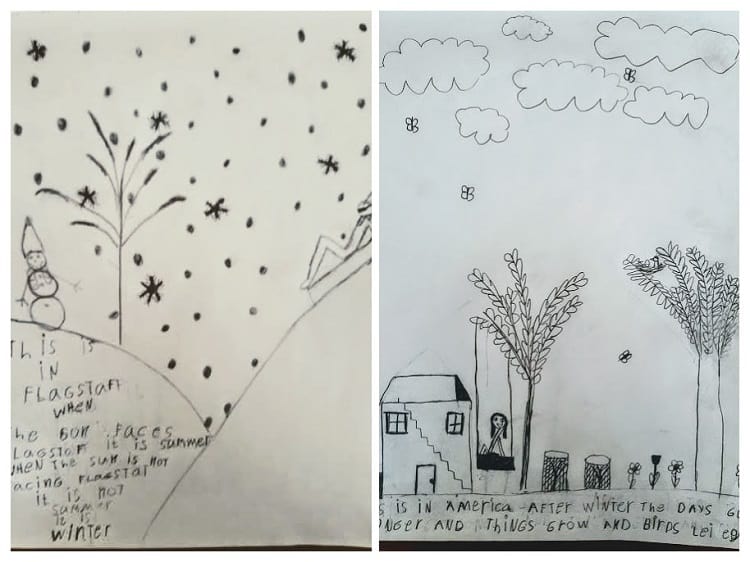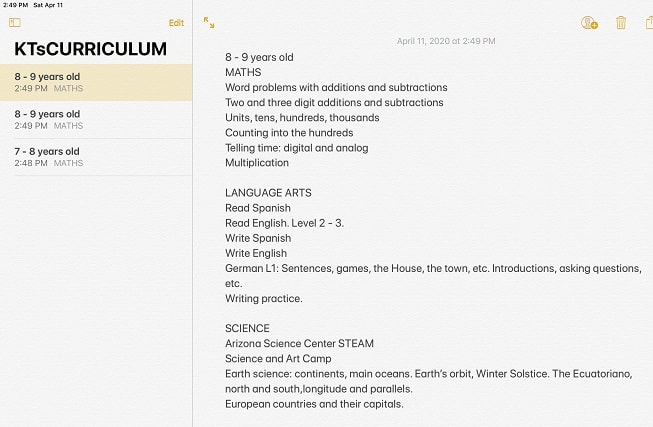
Our Version of 3rd to 4th grade
My daughter has been asking me what grade she is in. She has been taking classes that require her to fill in which grade she is in. We don’t unschool. We have some rigorous learning in some areas and more relaxed in others.
As you can read in Part 1 of How We Homeschool -Mindful and Age Appropriate, we didn’t do any real math stuff, reading, etc. I guess we didn’t start looking at “core skills” until she was almost 7 and 1/2. That is when most kids start 2nd Grade. For us that was April. We thought she needed to start learning Math at this point. As well as reading. I went through school math books, homeschool curriculum, I checked online to get a good handle of what kids need to know at that age.
In some ways it seemed overwhelming because of the nonsense kind of content, in other ways it seemed lacking in useful real life math skills, and in some ways it seemed like between the beginning of 1st grade through the end of 3rd, if you filter out unnecessary content, rearrange the necessary content and tackle skills when the kids are ready to learn, they can learn all the skills swiftly and effectively. In other words, REALLY FAST compared to how they learn at school.
Since that April when she was 7 and a quarter, until this April when she is 9 and a quarter, we have gone through all the math from 1st grade skills to beginning 4th grade skills. And believe me, we don’t have a kid who embraces academics. Naturally, she’d rather play, so we didn’t race through this stuff. She learned it leisurely but efficiently.
As I purchased work books and materials for teaching my daughter math in an age-appropriate and effective manner, because I am not a teacher but I am a project manager, content manager and educational game designer (Educational Game Producer), I weeded through the books we use and the content we can’t use. I devised a way that would fit a homeschooler not trying to recreate school at home.
Today, when she asks me what grade she is in I tell her: You just finished 3rd grade Math and going on to 4th grade Math; 4th grade science, 6th Grade German, in reading you’re like 1st or 2nd Grade, and Spanish you’re at University level. We laugh. How can you have all these subject fall under one grade level all the time!
We do homeschool everyday!
There is no point in taking time away from learning. This is not a concept my daughter ever ponders. You really don’t need to be on vacation from learning…that is just funny if you think about it. No?
I laid out a homeschool schedule that works out quite well, complete with curriculum and detailed activities and projects -you can find it here. But we don’t homeschool Monday to Friday as laid out. We aim to do homeschool 7 days per week. We don’t take weekends off necessarily -sometimes we do but we don’t make a point of not scheduling homeschool on weekends. We homeschool during Christmas, during summer (specially in summer), during vacation, etc. This worked out well for keeping continuity.
For 3rd to 4th grade we planned the curriculum and skills for that time. But it works better if we take time off if there is something better to do. At the end of the day with this method we find that sometimes we are ahead of the game. The challenge is to not take too much time off because she may forget. And keeping a good balance of time off math and focus on Science, projects, language arts, time to recap, etc.
Keeping continuity and not taking days off takes the pressure off because it’s more spread out. In addition, we can take classes and activities like Ceramics, co-op, sports, park-day (which takes up an entire day), play dates, field trips, travel, etc.
I like to keep track of the skills she acquires, things she learned, support workshops… I may forget, because this list is after the fact, it is not a forecast. But it keeps a record to know and refer to. It also gives me perspective because I do forecast by year and by month.

Here I explain how we organize by day, week, monthly, etc.
I designed a guide to help me teach my daughter Natural Science and Geography, which you are welcome to use I published it here. I know that schools and a lot of curriculum developers kids what is close to them first. So at school you start with the body parts (preschool), going to the house, going to the neighborhood, going to the town, going to the country, etc, then they make a detour into climate change and biology, moving on to astronomy and natural geography by the time they are in high school or university, if they get to it.
But I know the younger the kids are, the more they are able to make sense of the most outlandish stories. And they are fascinated about the stars, the sun and always asking questions about the world around us.
I couldn’t find anything that used a cross disciplinary approach to understanding the world around us for kids. And that used a methodology that mixed fun and engaging activities, straight forward explanations in a progression that the kids could grasp how something so simple as the days of the week and the fact that we have days, to the rotation of the Earth. How so much of the world we live in happens from above. By looking up.
So I designed my own curriculum. Which starts with that very concept as early as 4 – 8 years old (Free Natural Science Guide for 5 – 8 year olds) and another part Natural Science and Geography for 8 – 10 years old. I think we all get to know our house, our neighborhood and our bodies at some point without spending “school” time on that.
One day latter in the curriculum, when we started learning about angles and measuring degrees I pointed out that the circumference of the Earth or any circle measure 360 degrees, remember what else is about 360…365…? My daughter made a surprised noise, and virtually yelled “EVERYTHING IS CONNECTED!”. That is the point that we want to make with this curriculum. The interdisciplinary aspect of the learning is what makes learning more fun.
A curve ball that COVID-19 threw on my yearly and monthly forecasting was the following:
As you know, our homeschool approach is international and bilingual in nature.
Not only do we plan more or less when we’ll be, but we time the language in which the learning takes place in terms of where we will be (which country), for how long, and when to switch languages. For example we can do math problems in Spanish after getting back from Spain. But after a few months they start to loose relevance and our daughter starts to translate, because her entire world in the US is in English. The same when we go to Spain, Mexico…She needs a week to two weeks to start doing math and reading in Spanish -it’s the time it takes her personally to switch the language chip, so to speak.
As a result I have been planning ahead of time and last year I spent some time at book stores and Amazon Spain buying resources that were wonderful. Some of them for summer 2020.
I scheduled the curriculum correctly. All the materials would coincide with where we would be at from May to November. Right down to locations.
I got plenty of material in English of course, but I also planned a lot more for the summer and beyond, in Spanish!
After a year and a half of German lessons twice per week we were going to spend a week in Germany putting some of that learning in perspective. But no. The metric system doesn’t make as much sense in USA, much less with Spanish books. Portuguese geography and history looses the tangible connections you make when you are there. All the 4th grade word problem books I got in Spanish will be difficult to understand after a year of speaking more German than Spanish! The work-books about fractions…Greek and Roman History, Ok you can always learn it but it’s not as cool.
I am not sure we will be going into 4th grade the same way we planned, but I’m sure we will do it in style. We just need to see how Spanish kids, our friends, navigated the social isolation and lock down in their apartments for weeks on end to know that here at home, we have it made.
For those who spent their homeschool days indoors. I developed a project-based indoor and unplugged homeschool schedule to help navigate this lock-down without tying up most of their kids’ time to the computer. As much as the computer and tablets are awesome for so many reasons, compounding the time our kids spend on these devices to online school makes for an overload of unnecessary time in front of the screen.
